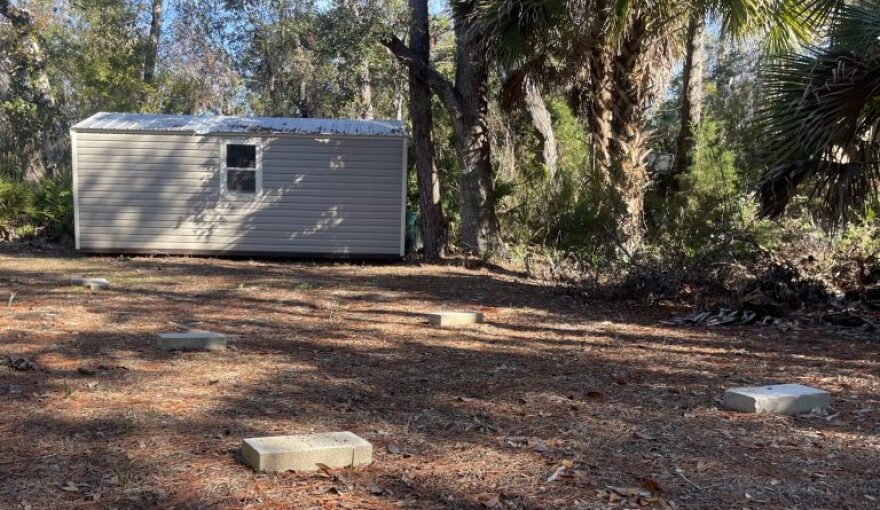Homeless, hopeless and helpless is how Lisa Bregenzer explains her last three months since Hurricane Idalia made landfall.
After living in Horseshoe Beach for seven years in a home that has been in her family for generations, she lost everything and is fighting to recover.
“I’ve always had a home, I’ve always had a roof over my head, always had security and for the first time, it’s been a nightmare,” she said.
Hurricane Idalia hit the Big Bend area as a Category 3 hurricane on Aug. 30. Over three months later, residents in the affected areas are still wrangling with government agencies for financial assistance to help rebuild or repair the damage from the natural disaster.
As of Dec. 5, the Federal Emergency Management Agency (FEMA) has had more than 76,000 registrations for a total of about $70 million in approved grants given to households.
Bregenzer said she has been jumping through hoops with FEMA since after the hurricane trying to receive a camper. But it seems there is always another hoop.
She said it all started with FEMA telling her the lot was too small. Then it was her oak tree that the agency did not want to fall on the camper, and then, it was the breed and size of her two dogs that stood in the way of government assistance.
“So for nine to 10 weeks, they promise you a camper, and it’s not coming, and it all boils down to Horseshoe Beach being in a flood zone,” she said. “Which they’ve known all along, so why keep stringing us along telling us we were getting a camper.”

She has been living with a neighbor and staying with family members after being denied assistance by FEMA. The American Red Cross offered to put Bregenzer and her family up in a motel but not in Dixie County.
“They want us to go live in Citrus County or Columbia County where we have no help, no support, no friends, no community,” she said, referring to counties that are at least 70 miles away.
FEMA media relations specialist Alberto Pillot said the agency typically tries to get people in rental assistance or temporary direct leasing because the travel trailers and housing programs tend to take longer to get them going.
“That’s what we say is the last resort we try to use because of the length it takes, so we want to try to absorb as much of the rental properties available within the area,” he said.
Pillot said that the agency is still processing applications as they come in, and the process varies from the time of the disaster. He said at the beginning of the disaster, it could take one to two weeks to receive assistance, but it depends on the number of applications received.
Another Horseshoe Beach resident, Vicki Benton, 66, lives in a camper so she can pull it out of town before a hurricane makes landfall.
On her property, she left behind a storage shed with an estimated $12,000 worth of personal items that were damaged by the storm. Although it is her primary residence, FEMA denied her request for assistance because their camper wasn’t damaged, she said.

“It’s just I was very disappointed because I thought that when FEMA came in, they would help everyone no matter what you lived in,” she said.
Benton said she was approved for a Small Business Administration (SBA) loan for $4,500, but it doesn’t cover nearly half the costs and is almost not worth getting.
Just up the coast, Bob Berger, 77, who lives in Steinhatchee on Cooey Island, said he and his family had hardly any help from FEMA and SBA after being denied by both agencies. He had no insurance because he said he and his wife couldn’t afford it, living in a flood zone.
After his home was flooded with 18 inches of water from the hurricane, he was left with a floor that began to cave in, a hole in the roof and a damaged air conditioning system.
With total costs for damage still uncertain, they have received about $1,500 from FEMA.
“It was a drop in the bucket for what we need to get our house fixed,” he said.
After being asked what makes a home more qualified than another to receive assistance from FEMA, Pillot said, “Again, just because you have a bigger family doesn’t mean, or less family, that you’ll get different grant dollars.”
He said that the process to see whether someone receives assistance is based on the type of disaster and how each home is affected.
On Nov. 8, Gov. Ron DeSantis signed legislation that provided hurricane relief for the counties hit by Hurricane Idalia. The assistance included $176.17 million in funding for the My Safe Florida Home program.
The program has 17,600 applicants who have applied for financial help. The goal is to get homes up to the latest building standards to protect the structures from future storms.
Berger said he had never heard about the state program until recently, but he found out after the application deadline.
“I’d like to know who heard about it, how they heard about it, and who actually is going to get some of these funds to raise their homes,” he said.
While funds are being granted and legislation and bills from vendors are being signed, some residents in Keaton Beach, including Ann Loose, 59, are still waiting for the debris to be picked up more than three months later.




